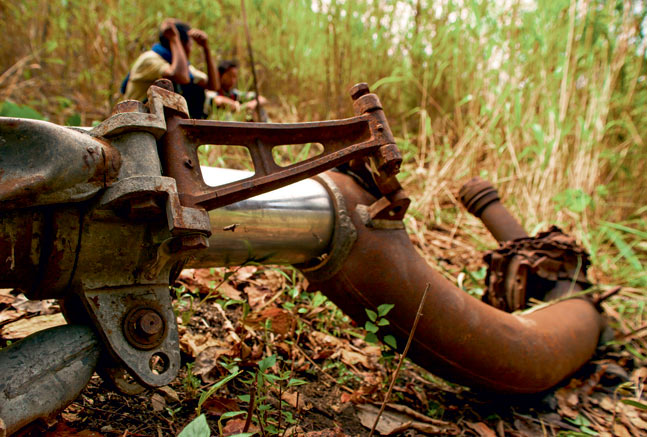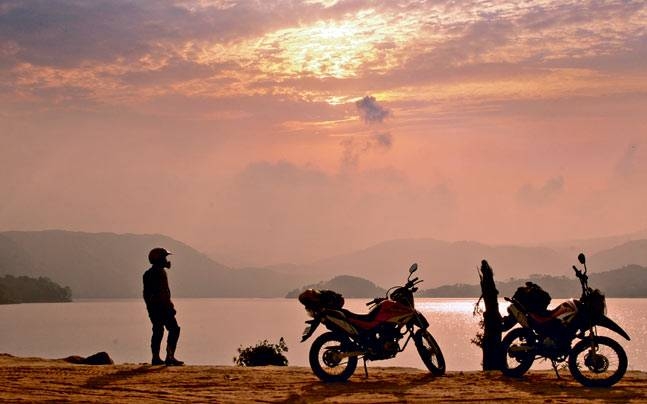A chance pit stop for shelter turns into a discovery of a lifetime. Shahwar Hussain recalls the magical moment of stumbling upon remains of pre-World War II aircrafts that had crashed in the jungles of Nagaland.
The sky had promised rain since dawn and when the clouds opened up in the afternoon, it poured cats and dogs. Big blobs of rain stung my face, forcing me to take shelter in a shed by the roadside. In Nagaland, you will find sheds like these all over. They are meant to shelter villagers who walk long distances to get to town.
There were a few old men in the shed waiting for the rain to stop so that they could carry on home. But the rain gods had different plans and so one of the men got a fire going. He put a piece of bamboo in the fire with water and tea leaves and let it boil. I got talking with them as the man poured strong black tea in a bamboo mug for me and offered me a hand-rolled cigarette. The man who spoke the least, said the most interesting thing which set my mind racing. As I strapped on my helmet when the sky held, the drone of an aircraft drifted down to us from afar. He looked heavenwards and said “I hope this won’t fall like the plane in the jungle.” Removing my helmet in a flash I asked “plane in the jungle?” And the man casually replied saying he’d once seen the remains of an airplane in the jungles many years back.
An airplane in the jungles-he pointed to the blue mountains yonder and said it lay beyond the third range of mountains. Vague, but I will trace it, I thought to myself. Tracing it out was easier said than done. It took the jungle nine long years to share its secret with me. I got to know that the remains of the airplane lay scattered over a large area under the jurisdiction of a new village named Tsurevong.
My photographer friend, Anuj and I decided that motorcycle was the best way to travel to these far flung villages where you can see life in all its rustic glory. A few kilometres out of Kohima, we crossed villages like Mima, Cakhabama, Pfutsero, Chizami, Losami, Lanye, Jessami, Meluri, Akhegwo, Longmatra; we then bypassed Kiphire town and went onto Pungro. As we approached Pungro, I watched the beautiful Zinki River flowing gently and then disappearing across a bend as it made its way to the Chindwin River in Myanmar.
By village standards, we reached late, and Thronghokiy, a teacher at the local school, put us up in the newly built government guest house where we feasted on delicious fish curry made by his wife. The next morning, the last of the 45 km to Tsurevong village were spent offroading. Meanwhile Thronghokiy had sent word to the village and said someone would wait for us along the way. K. Athong, a village head (Gaon Bura) met us on the way and led us to the village. Tsurevong is a new village, with only 38 households, was set up a couple of years back. Cool wind from the mountains descended upon us as we sat outside the headman’s house sipping sweet tea. I waited impatiently to meet old man Kimusai, the only man who had seen the aircraft come down in flames from close quarters.

As I finished my third cup of tea, the old man appeared. He was in his 90s but he walked straight and although he carried his long red walking stick, he never really seemed to use it. Kimusai and I sat on a large rock as he narrated the story. His memory was sharp and he spoke as if it happened just yesterday. It was in late 1942, Kimusai lived in Salomi village and he wanted to treat his new bride with a wild boar feast. In fading light, Kimusai stood under a tree at the very top of a hill when he heard a loud wailing sound. He explains “I saw a giant bird with its wing on fire circling close overhead. It was crying out loudly’. As he watched, the circling plane narrowly missed a hillock and an instant later came down in the forest just below the hill where he was standing.
“There were a thousand fires and it made an ear splitting noise as if the moon has come crashing down on earth!” said Kimusai. He was a brave hunter and a warrior but he had never ever seen such a massive explosion so close. He dropped his kill and ran all the way to the village.
The burning aircraft was seen as a message that the Gods were angry. Prayers were held, mithuns were sacrificed and nobody was allowed to hunt. In a few days’ time, the village started running out of food and livestock. So Kimusai and a couple of hunters decided to investigate the giant bird.
They had never seen an aircraft before but knew that it was not some bird fallen from the heavens.
As they cautiously made their way through the debris, they found human remains of three dead bodies. Kimusai and the others buried the three airmen some distance away from the aircraft. They collected a few things from the site including a gun and didn’t return there for many years.
“The place was haunted by the spirits of the men who died there” Kimusai said. He didn’t specify how and I didn’t ask anymore. It was most probably a C-47 transport plane that had taken off from Chabua Airbase in Assam. Before the United States were officially engaged in World War II, American pilots flew these supplies planes across the high snow covered jagged peaks of Himalayas to ferry supply to the armies of Chiang Kai-shek in Kunming in western China who was fighting against the Imperial Japanese army. Like so many others, this plane never made it back to base after dropping its cargo in Kunming.
The evergreen jungle soon overgrew the area and it was only in 1967 that the villagers ventured into the area again. Kimusai shifted to a new village, Longkhimvong, which was being established some kilometres away from the crash site and led the villagers to the aircraft. They started clearing the forest for cultivation and the huge bulk of the downed aircraft was revealed.
Kimusai is a great story teller and by the time he finished, the sun had gone down the hill and the skies turned a flaming red. He had a faraway look in his eyes as he stood up with a deep sigh and made his way home.
That night we stayed at a community hut by the village church. Dinner was rice, boiled vegetables and meat of some jungle fowl. The headman’s wife made some jungle fowl soup which was unbelievably delicious. We sat in the kitchen by the fire and ate the simple food served with a liberal dose of affection. The concept of breakfast as the world knows it does not exist in most of Nagaland. So at 7 am, we were served rice and vegetable and with a full stomach, we made our way to the much-awaited crash site.
The site was a few kilometres downhill from the village. We headed there with Thuviki and Retringia leading the way. The fact that some parts of the forest were burnt off recently for jhum cultivation made things a bit easier for us. It was evident that the villagers had not burnt the forest at the crash site for a few years. Retringia slashed a path with his razor sharp machete and we followed close behind. It was deadly quiet except for the occasional call of the lone eagle that circled the sky.
Along the way, we found still shiny landing gear, some twisted wheels, parts of gearbox, crankshafts, a fan of some sort and some other heavy parts scattered over a very large area. We walked down stream, slashing away the thick foliage and found a number of large engine parts. I am sure a concentrated search would reveal a whole lot of parts.
Even though the area had been burnt and cleared in the past, we were surprised to find pieces of unburnt fabric and rubber hose pipes scattered in the area. A whole lot of parts are buried underground and some keep popping up during cultivation almost every year. A couple of years back, a villager dug up an old radio set and a rusted and loaded revolver!
It is an overwhelming sense of discovery-for something that I have searched for for a very long time. The fact that the headman told me that I was the first person from mainland India to visit the site made it even more satisfying. As I sat on a fallen tree and looked down the valley, I couldn’t help but imagine the plight of the crew as they came down in flames. Even if they had survived the crash, it would have been near impossible for the wounded to survive the dense jungle crawling with wildlife. After half a century, nobody knew where the three graves were but I said a silent prayer for the men who died so far away from their homeland.
The remains lay in a far and obscure place but it is well worth a visit. It makes civilians realise the plight of soldiers. If you are visiting Tsurevong, travel another 25 km and visit the village of Mimi on the borders of Myanmar. I was fortunate to see the villagers harvest honey from hives of the rock bee. It is harvested twice a year, in April and in October. There were 85 hives on a sheer rockface with a 300 ft vertical drop; the villagers harvested honey using traditional means. Scary but interesting-and the honey tasted just great!
Mimi has a tradition of making pottery mostly by women and they do not use the traditional wheel. They beat the clay by a wooden plank and shape it up into all sizes of pots. They also make some fabulous smoking pipes. I bought a pot of honey fresh from the hive and the earthen pot had the inscription “Made In Mimi.”
This story originally appeared in Travel Plus
Photographs: Anuj Singh
Author: Shahwar Hussain
